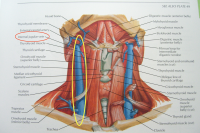- Apr 28, 2014
- 272
- Tinnitus Since
- 2008
- Cause of Tinnitus
- ME/CFS, Dysautonomia
@chronicburn
@Sjtof
@Mr. Cartman
I can't say for sure if the needles helped, I'd say no.
I'm getting my neck MRI on Monday. My neurologist did not include the back. I don't expect anything to show up. I used to think the trapezius was a big one early on, but I've had less focus on it in recent years. It is supposed to be a common effected muscle though.
I would not expect your MRI including the upper back to show anything. Your problem is most likely muscle related. These scans are all structural, not functional scans, so nothing will show up. X-rays same thing I guess. I got an x-ray of my neck by an orthopedic surgeon once and he said my neck was not broken, so that was not much help.
There are some experimental scans that can detect trigger points supposedly using specially designed high resolution ultrasound equipment. But, even if you could image it it would prove your condition is trigger points related, but that still isn't telling you what is causing the trigger points or how to treat it and those scans are not available clinically or perfected yet. The University at the forefront of that research and the only one most recently doing research is at George Mason University near me.
Some day symptomatic or maybe curative treatment may be effective with a physical therapist that can use a trigger point ultrasound image device and a specially designed tool to treat the trigger points like the "well-wave" http://hillsdalewellness.com/well-wave.html . However, we don't know if this is treating the root cause or would work.
This is the research on the ultrasound image device of trigger points from GMU:
http://neuroscience.gmu.edu/people/ssikdar
http://mason.gmu.edu/~dturo/project.html
http://www.ncbi.nlm.nih.gov/pmc/articles/PMC3493167/
http://www.jultrasoundmed.org/content/30/10/1331.long
In order to image the trigger points you have to use a special type of ultrasound and also a vibration source. The other higher-cost alternative was the MRE scan which was an MRI elastrography specially calibrated for muscle trigger points, but that is not the lowest cost or most up-to-date approach.
But, as I said, this is still only part of the puzzle and you can't even get those scans.
@Sjtof
@Mr. Cartman
I can't say for sure if the needles helped, I'd say no.
I'm getting my neck MRI on Monday. My neurologist did not include the back. I don't expect anything to show up. I used to think the trapezius was a big one early on, but I've had less focus on it in recent years. It is supposed to be a common effected muscle though.
I would not expect your MRI including the upper back to show anything. Your problem is most likely muscle related. These scans are all structural, not functional scans, so nothing will show up. X-rays same thing I guess. I got an x-ray of my neck by an orthopedic surgeon once and he said my neck was not broken, so that was not much help.
There are some experimental scans that can detect trigger points supposedly using specially designed high resolution ultrasound equipment. But, even if you could image it it would prove your condition is trigger points related, but that still isn't telling you what is causing the trigger points or how to treat it and those scans are not available clinically or perfected yet. The University at the forefront of that research and the only one most recently doing research is at George Mason University near me.
Some day symptomatic or maybe curative treatment may be effective with a physical therapist that can use a trigger point ultrasound image device and a specially designed tool to treat the trigger points like the "well-wave" http://hillsdalewellness.com/well-wave.html . However, we don't know if this is treating the root cause or would work.
This is the research on the ultrasound image device of trigger points from GMU:
http://neuroscience.gmu.edu/people/ssikdar
http://mason.gmu.edu/~dturo/project.html
http://www.ncbi.nlm.nih.gov/pmc/articles/PMC3493167/
http://www.jultrasoundmed.org/content/30/10/1331.long
In order to image the trigger points you have to use a special type of ultrasound and also a vibration source. The other higher-cost alternative was the MRE scan which was an MRI elastrography specially calibrated for muscle trigger points, but that is not the lowest cost or most up-to-date approach.
But, as I said, this is still only part of the puzzle and you can't even get those scans.

 Member
Member
 No idea. I might find a different physio later, but for now Im going to have my neck and back MRI done, and ask them to pay close attention to whats going on there, because something is way off.
No idea. I might find a different physio later, but for now Im going to have my neck and back MRI done, and ask them to pay close attention to whats going on there, because something is way off.
 .
.
 .
. .
. .
.